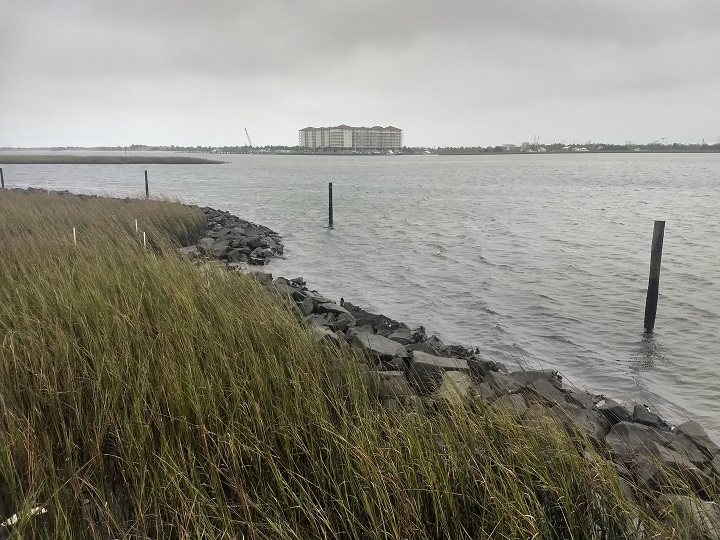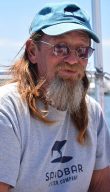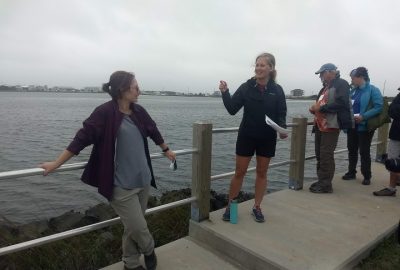
BEAUFORT – As a covered sightseeing tour ferry circled the Sandbar Oyster Co.’s shellfish lease at the mouth of the Newport River, David Cessna gestured and told the about three dozen aboard that “On the starboard side of the boat, that’s right for you landlubbers, you’ll see some white objects sticking out of the middle of the river. That is a community of approximately 40 million oysters.”
Cessna, who goes by Clammerhead, is a seventh-generation Carteret County commercial fisherman. He and his business partner, professor Niels Lindquist of the University of North Carolina Institute of Marine Sciences in Morehead City, created a biodegradable surface for oysters to grow on and thrive as part of living shorelines. Together, they founded Sandbar Oyster Co.
Supporter Spotlight

With his face etched from years working the waters in the commercial seafood industry, Cessna explained the ins and outs of their business during one of the three field sessions that kicked off the Living Shorelines Tech Transfer Workshop held last month at the Beaufort Hotel. The workshop was hosted by Restore America’s Estuaries and the North Carolina Coastal Federation, which publishes Coastal Review Online.
“North Carolina practitioners – and (the federation) in particular – are pioneering living shorelines research and implementation. It was a natural fit for us to host the workshop there. Beaufort was a fantastic location that offered both a beautiful venue and proximity to real world, on-the-ground living shorelines projects,” said Jeff Benoit, president of Restore America’s Estuaries.
The workshop brought together more than 200 from across the country and Canada to learn about techniques, regulation, community engagement and changing attitudes toward living shorelines.
In addition to the Sandbar Oyster Co.’s shellfish lease at the mouth of the Newport River, the Beaufort/Morehead City field session included visits to living shorelines on Pivers Island, which is home of the Duke University Marine Laboratory and the National Oceanic and Atmospheric Administration Beaufort Lab, and the Rachel Carson Reserve, a part of the N.C. Coastal Reserve and National Estuarine Research Reserve. Attendees could view salt marsh grass plantings, granite sills, loose oyster shell placement, oyster shell bag marsh toe revetments and marsh toe revetments.
Learning about living shorelines pic.twitter.com/y2VmmV7aKt
— Jennifer Allen (@AllerJenn) October 8, 2019
Supporter Spotlight
Those not on the Morehead City/Beaufort field session either visited Hammocks Beach State Park’s Jones Island in Swansboro or toured living shorelines at the Trinity Center and North Carolina Aquarium at Pine Knoll Shores on Bogue Banks. In addition to the morning field sessions, the two-day workshop featured presentations, poster sessions and networking.
“The Coastal Federation is one of Restore America’s Estuaries member organizations and together they feature and promote the benefits of living shorelines nationwide,” Lexia Weaver, coastal scientist and central regional manager for the federation, told Coastal Review Online. “We were thrilled about the opportunity to host the workshop in coastal North Carolina to show other living shoreline practitioners our work and exchange successes and lessons learned.”
She explained that living shorelines are environmentally friendly shoreline stabilization techniques that help reduce shoreline erosion while protecting and restoring valuable salt marsh and oyster habitat. They’re also an alternative to shoreline hardening.
“Living shorelines have proven to fare better through hurricanes and storms than bulkheads or seawalls, are less expensive and require little to no maintenance once established. Living shorelines slow down and dissipate wave energy rather than reflecting it, thereby reducing scour of both the salt marsh wetlands and uplands,” Weaver said. “They incorporate natural elements such as salt marsh grasses and oysters that naturally function to protect shorelines from erosion in addition to their fish and shellfish habitat benefits. The salt marsh grasses and oysters also help to improve water quality through their filtering capabilities.”
Cessna told the group on the ferry, who were bundled up against the rain and wind on that chilly, cloudy morning on the first day of the workshop, that he and Lindquist picked the location for their lease in the Newport River because it was intertidal and faced the roughest conditions plus, he didn’t know of anything else that been in that spot in his lifetime.
“We wanted somewhere we could try and challenge some of the things that we face in both living shorelines and aquaculture, and this seemed like a good place to do it,” he said.
When Cessna and Lindquist created their trademark Oyster Catcher substrate, the primary goal was to be seed farmers, Cessna said. But if they were to stumble across another use for the material, they would go in that direction.
“Now we’re constantly looking for ways to improve our living shoreline and restoration techniques using this material and we don’t do so much aquaculture anymore. But our passion is trying to save some of this environment,” Cessna said, adding that sea level rise is what got them interested in living shorelines.
The ferry then made its way to the 24-acre Pivers Island to visit two shoreline-stabilization projects.

Carolyn Currin, a microbiologist with the NOAA lab was standing by one of the living shorelines located on the east of Pivers Island, facing downtown Beaufort.
“This was a sandy beach when I got here in 1983,” Currin said. Then during the 1990s, a series of hurricanes hit the area and caused massive erosion, spurring an effort to plant marsh there.
In May 2000, a group of NOAA and Duke staff planted Spartina alterniflora, a smooth cordgrass. Oyster cultch was placed there July 2000, July 2006 and August 2007 by the Division of Marine Fisheries. The staff volunteered their time, the plants were collected from nearby donor marshes and the oyster cultch was provided by the N.C. Division of Marine Fisheries.
“Within a number of years, sediment accumulated behind the oyster reef, the marsh grew out, the oyster reef is up, really high vertically,” Currin said of the NOAA living shoreline. “It’s been a really successful project.”
Across the small island, Rachel Gittman, assistant professor in the Department of Biology and Coastal Studies Institute at East Carolina University, and Devon Eulie, assistant professor in the Department of Environmental Sciences at the University of North Carolina Wilmington, were standing near a stone sill living shoreline, the Duke living shoreline.
Gittman explained that in the early 2000s, a series of stone living shorelines were installed throughout Carteret County. “This is a classic example of a stone sill living shoreline in this part of the state.”
The site has been monitored for decades and shows a consistent pattern of accretion, Gittman added.
Eulie explained that many of the natural marshes are not growing at the same pace that a sill-protected site is, “But even those sites, as quickly as they’re accreting, are still not keeping up with sea level rise for the area.”
Additionally, many of these sites were monitored during recent storms and most are resilient to the hazards of storms. Compared to bulkheaded sites after storms, these sites show that the living shorelines fared well.

The big question though, Eulie said, is that in the long term, 50 to 100 years, how are the living shorelines going to hold up? “That’s something that the living shoreline community is working on.”
Currin told Coastal Review Online in a follow-up interview that when the NOAA living shoreline was established in 2000 using Spartina transplants and loose oyster shell placed offshore of the marsh plantings, oyster recruitment – the natural accumulation and growth of oysters – quickly led to a cohesive live reef, and the salt marsh expanded behind the reef.
“The current oyster reef-marsh shoreline has experienced the recent hurricanes without damage, and we have found that the marshes are able to trap sediments from the overlying storm tides, which increases the marsh surface elevation and increases its long-term resiliency,” she said.
The Duke living shoreline, which consists of a rock sill and planted marsh, has been part of the NOAA- National Estuarine Research Reserve System’s long-term monitoring effort since 2004. The surface elevation tables, portable devices used to measure relative elevation changes, at the site document a significant increase in marsh surface elevation over time, and expansion of marsh habitat. Similar to the NOAA living shoreline, hurricanes have deposited sediment here.
“At both sites, although the current marsh habitat and shoreline edge have been maintained, large storm surges have caused some erosion on the uplands adjacent to the marsh, demonstrating the need to maintain a graded, vegetative buffer between the marsh and upland property,” Currin said.
The final stop of the field session was the nearby Rachel Carson Reserve. Gittman pointed across the water to Carrot Island from the ferry, one of the handful of islands making up the reserve. The weather and water were not cooperating to allow on-foot exploration.
Gittman, who has worked at the site since 2012, told the crowd,“The reserve’s goal is managing their resources but they also want to be a public demonstration site for science, research and now living shorelines,” adding that the reserve has allowed researchers to experiment with material.
“Right now, this is a playground for scientists to decide ‘can we figure out other materials besides stone that we can use for living shorelines in a place where we know we have really good oyster recruitment?’” Gittman said. “I don’t think anything we’re using is a viable option if you don’t have intertidal oysters because you’re not going to grow oysters on it. It’s intended for oyster-based shoreline stabilization.”
Weaver told Coastal Review Online that shoreline hardening, such as seawalls and bulkheads, which have been the norm for years, destroyed much of the state’s estuarine habitats that are vital to commercially and recreationally important fisheries, and affected coastal water quality.
“We need to think outside the box, get out of our comfort zone, and protect the natural shorelines that we have left with the significantly more effective, economical and longer-term living shoreline techniques,” Weaver explained. “We are slowly getting the word out about these practices, and the use of living shorelines has increased in the state, but unfortunately, we are still a long way away from making living shorelines the norm instead of bulkheads and seawalls.”








